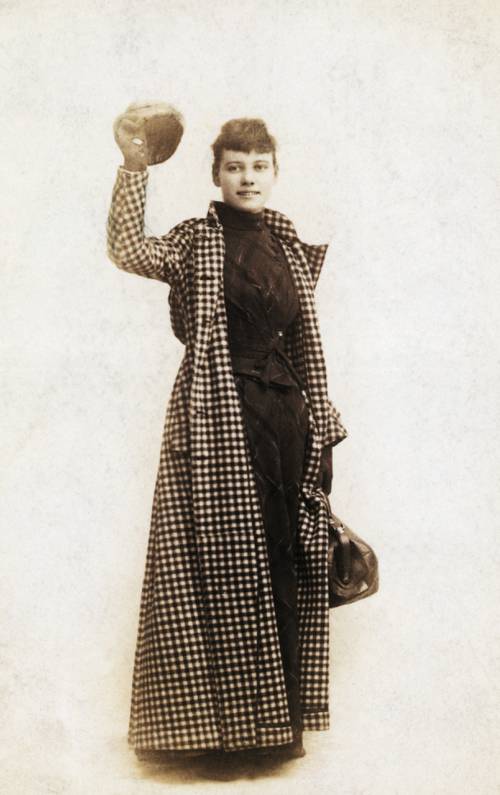
FAQ About Nellie Bly

Who was Nellie Bly?
Nellie Bly was the pen name of Elizabeth Jane Cochran, an American journalist known for her pioneering investigative reporting and her daring adventures. She was born on May 5, 1864, in Cochran's Mills, Pennsylvania. Bly is most famous for her undercover exposé on the conditions of asylum patients at the Women's Lunatic Asylum on Blackwell's Island, as well as her record-setting circumnavigation of the globe in 72 days, inspired by Jules Verne's novel "Around the World in Eighty Days."

What was Nellie Bly's real name?
Nellie Bly's real name was Elizabeth Jane Cochran. She adopted the pseudonym for her journalism work, which was inspired by the title of a Stephen Foster song, "Nelly Bly."

What significant impact did Nellie Bly have on journalism?
Nellie Bly is often credited with pioneering investigative journalism, a field in which reporters deeply investigate a single topic of interest, often with the aim of uncovering truth or exposing corruption. Her most significant impact came from her undercover work, particularly her 1887 exposé of the brutal conditions in the Women's Lunatic Asylum. Her work compelled authorities to implement reforms in the treatment and care of the mentally ill. Furthermore, by traveling around the world in 72 days, she demonstrated the power of journalism to entertain while informing, thus broadening the scope of journalistic topics.

What is Nellie Bly best known for in the field of investigative journalism?
Nellie Bly is best known for her daring undercover investigation of the Women's Lunatic Asylum on Blackwell's Island. By feigning insanity, she intentionally got herself committed to the asylum. During her ten-day stay, she uncovered and later reported on the horrid conditions and mistreatment of patients, which led to a grand jury investigation and significant reforms regarding the treatment of the mentally ill.

What inspired Nellie Bly to travel around the world in 72 days?
Nellie Bly was inspired to travel around the world by Jules Verne's popular novel, "Around the World in Eighty Days." The novel presents a fictional account of a man attempting to travel around the globe in 80 days. Bly proposed the idea to her editors at the New York World newspaper, suggesting that she could beat the fictional record. Her successful journey not only set a real-world record but also fascinated and captivated global audiences.

How did Nellie Bly get into journalism?
Nellie Bly began her journalism career after writing a compelling letter to the editor of the Pittsburgh Dispatch in response to an article entitled "What Girls Are Good For." Impressed by her writing, the editor, George Madden, offered her a job. At the time, it was common for women to take pseudonyms, and thus she adopted the name "Nellie Bly." Her early work often focused on women's rights issues, opening the path for her future in investigative journalism.

What challenges did Nellie Bly face as a female journalist?
As a female journalist in the late 19th and early 20th centuries, Nellie Bly faced numerous challenges. The journalism industry was predominantly male, and women were often relegated to writing about domestic subjects. Bly, however, pushed against these limitations by pursuing ambitious stories, such as her undercover work and global journey. Despite skepticism and resistance from her male colleagues, her tenacity, boldness, and groundbreaking work won her widespread recognition and demonstrated the value of women in the field of journalism.

What were the outcomes of Nellie Bly's exposé on the Women's Lunatic Asylum?
Following Nellie Bly's exposé of the Women's Lunatic Asylum, which was published in the New York World, there was an immediate public outcry and governmental attention. The grand jury launched an investigation into her findings, and as a result, the asylum came under significant scrutiny. This led to increased funding for the care of the mentally ill and improvements in the conditions and treatment of patients. Her work highlighted the power of the press to affect change and reform corrupt or harmful practices.

Did Nellie Bly write any books?
Yes, Nellie Bly wrote several books during her lifetime. Her publications include "Ten Days in a Mad-House," which details her experiences during her undercover investigation of the Women's Lunatic Asylum, and "Six Months in Mexico," based on her time reporting in Mexico. Both books offer vivid accounts of her observations and experiences, showcasing her talents in both journalism and narrative writing.

How did Nellie Bly's journey around the world impact her career?
Nellie Bly's journey around the world significantly boosted her career, establishing her as a household name internationally. The adventure was widely covered, capturing the public's imagination and solidifying her status as an intrepid and innovative journalist. Her feat demonstrated the potential of publicity-focused stories in journalism, leading to new opportunities and adventures in her subsequent career.

What methods did Nellie Bly use in her investigative reporting?
Nellie Bly was known for her immersive and undercover journalism techniques, which were groundbreaking at the time. She often put herself at significant personal risk to gather firsthand information. For example, to investigate the conditions of women's asylums, she pretended to be insane to gain admission and report the truth from the inside. Her immersive approach allowed her to gather authentic, impactful stories that readers could connect with emotionally.

Where did Nellie Bly's undercover investigation take place?
Nellie Bly conducted her undercover investigation at the Women's Lunatic Asylum on Blackwell's Island, which is now known as Roosevelt Island, located in the East River of New York City. This location was notorious for its poor treatment of patients and harsh conditions, which were vividly detailed in Bly's exposé.

How long did it take Nellie Bly to travel around the world?
Nellie Bly completed her trip around the world in 72 days, 6 hours, 11 minutes, and 14 seconds. Her journey began on November 14, 1889, and ended on January 25, 1890. This achievement brought her immense fame and public adoration, as it was a real-life realization of the fictional journey described in Jules Verne's "Around the World in Eighty Days."

What did Nellie Bly accomplish with her journey around the world?
With her journey around the world in 72 days, Nellie Bly set a new record for her travel time following a route across Europe, Asia, and North America. Her accomplishment highlighted the advancements in transportation technology of the era and demonstrated the capabilities of a single, determined reporter to capture worldwide attention. It also challenged gender norms by showing that women could take on physically and mentally demanding challenges typically reserved for men.

Did Nellie Bly have any other notable careers besides journalism?
Aside from journalism, Nellie Bly was also an industrialist and inventor. After marrying millionaire manufacturer Robert Seaman, she became involved in the management of the Iron Clad Manufacturing Company, where she patented several inventions related to oil drum manufacturing. However, her business ventures eventually ended in financial difficulties, prompting her to return to journalism later in her life.

What influence did Nellie Bly have on future generations of journalists?
Nellie Bly influenced future generations of journalists by demonstrating the effectiveness and importance of immersive and investigative reporting. Her work paved the way for a new form of journalism that goes beyond mere reporting, involving the journalist's active participation in uncovering stories. She also helped break down gender barriers, inspiring many women to pursue careers in journalism and other fields traditionally dominated by men.

When and where was Nellie Bly born?
Nellie Bly was born on May 5, 1864, in Cochran's Mills, a small town in Armstrong County, Pennsylvania, USA. Her birthplace was part of the area that has inspired her pen name.

What was Nellie Bly's approach to addressing social issues?
Nellie Bly's approach to addressing social issues involved using her platform as a journalist to expose the wrongs and injustices in society. Her investigative work sought not only to report facts but also to evoke empathy and drive reform. By uncovering the realities faced by marginalized groups, such as asylum patients and working women, Bly brought critical social issues into public consciousness and prompted discussions on necessary reforms.

How did Nellie Bly's work influence asylum reform?
Nellie Bly's work directly influenced asylum reform by bringing public attention to the abuses and poor conditions within mental institutions. Her undercover operation at the Women's Lunatic Asylum on Blackwell's Island exposed significant mistreatment and negligence, leading to a widespread public outcry. As a result, the asylum underwent reforms, including improvements in patient care and allocation of better funding, showcasing the profound impact of her journalism on policy change.

What legacy did Nellie Bly leave behind?
Nellie Bly left behind a legacy as a trailblazer in investigative journalism and as a figure who challenged societal norms. Her fearless pursuit of truth and justice set new standards for journalistic integrity and courage. She is remembered not only for her journalistic feats but also for her role in advocating for the rights of the marginalized. Her story continues to inspire journalists and non-journalists alike, serving as a testament to the power of brave reporting in changing the world.
